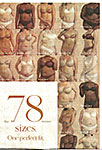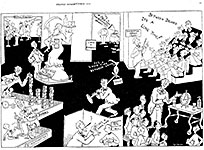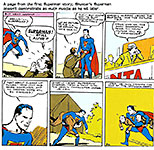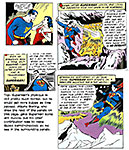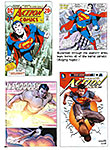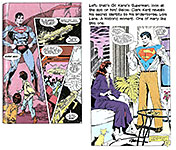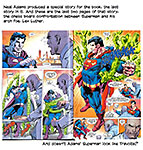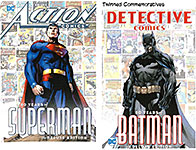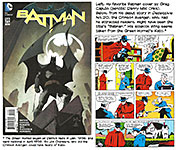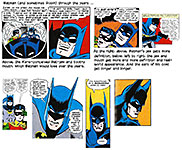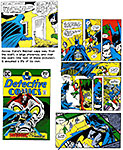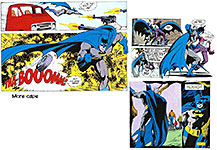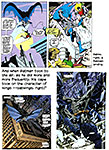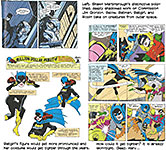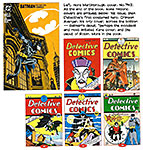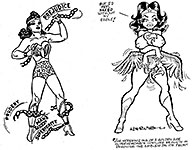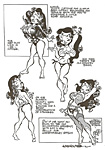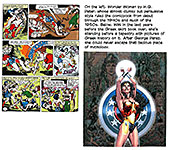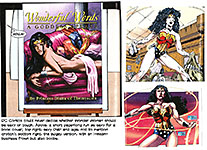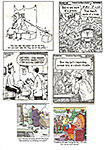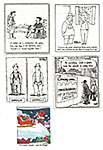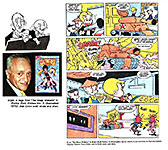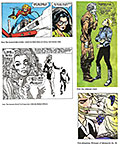 |
||||||||||||||||||||||||||||
|
Opus 396A (August 31, 2019). Open Access Month continues for a couple more weeks so we can showcase what=s here this time in Part One (Opus 396A) as well as what we=ll be doing in Part Two (Opus 396B). This time, we celebrate the return of Non Sequitur to a few (too few, alas) newspapers and we review DC Comics= commemorative volumes celebrating the 80th anniversaries of Action Comics and Detective Comics and the 75th of Wonder Woman, and the 50th of Woodstock, the event (with an honorable mention for the character in Peanuts). And we also examine August=s crop of editorial cartoons. Here=s what=s here, in order, by departmentC:
Editor=s Note: The longest articles are marked with an asterisk (*) to help you decide which ones to visit right away and which ones to postpone to another day. Excessively long pieces get two asterisks (**).
NOUS R US *Non Sequitur ReturnsCSlowly More Editoonery Dust Being Bitten Comics Censored in Prison Stonewall and Woodstock Anniversaries Woodstock In Peanuts
ODDS & ADDENDA Garrison at White House B.C. Movie? Peanuts Movies Re-mastered
FUNNYBOOK FAN FARE Coffin Bound Reviewed
TRUMPERIES The Ego Antics of the Trumpet
**EDITOONERY Editorial Cartoons of the Last Month
RANCID RAVES GALLERY Pictures Without Too Many Words Dr. Seuss Drinks Before Kids Books New Yorker Book Covers Comicbook Pin-Up
BOOK REVIEWS Critiques & Crotchets Action Comics: 80 Years of Superman Detective Comics: 80 Years of Batman Wonder Woman: A Celebration of 75 Years
BOTTOM LINERS Single Panel Magazine Cartooning Looking at Some
PASSIN= THROUGH Ernie Colon
QUOTE OF THE MONTH If Not of A Lifetime AGoddamn it, you=ve got to be kind.@CKurt Vonnegut
Our Motto: It takes all kinds. Live and let live. Wear glasses if you need =em. But it=s hard to live by this axiom in the Age of Tea Baggers, so we=ve added another motto: Seven days without comics makes one weak. (You can=t have too many mottos.)
And in the same spirit, here=sC: Chatter matters, so let=s keep talking about comics.
And our customary reminder: don=t forget to activate the ABathroom Button@ by clicking on the Aprint friendly version@ so you can print off a copy of just this installment for reading later, at your leisure while enthroned. Without further adieu, then, here we goC:
NOUS R US Some of All the News That Gives Us Fits
NON SEQUITUR RETURNSCSLOWLY Wiley Miller slipped up last February and let a heartfelt obscenity about the Trumpet sneak into a Sunday Non Sequitur; see Opus 388b. Enraged newspaper editors (but not readers), accusing Miller of violating trust with them, dropped the strip. By the score. The strip was one of the most popular in the country, running in about 700 newspapers; nearly half of these subscribers cancelled Non Sequitur. Since syndicated strip cartoonists are paid according to the number of papers their feature runs in, Miller suffered a substantial blow to his pocketbook. Miller sent out letters of apology to papers that had cancelled. [That letter appears below.] According to Rob Curley, editor of the Spokesman-Review in Spokane, fewer than a dozen papers have since permitted Non Sequitur to return to their comics line-up. Happily, the dozen include some big circulation papersC Los Angeles Times, Cleveland Plain Dealer, Newark Star-LedgerC which pay a fee based upon circulation, so their return affected Miller=s bank account more than the mere number would indicate. Another half-dozen new papers have picked up the strip. Among the returning newspapers is the Spokesman-Review, which had the prescience to ask its readers whether Non Sequitur should be returned to the comics pages. AThe vote wasn=t even close,@ the paper reported. AOut of the nearly 1,400 readers who phoned and e-mailed us, fewer than 40 didn=t want the strip to return. ... The other 98% wanted it back in the paper.@ Curly reported that the paper=s phone system was overwhelmed: ABefore 9 a.m., the special phone number and voicemail we=d set up to take people=s calls on the issue was completely full. Heck, it might have been full way before then, but I didn=t wake up until that time. ABecause of that, people were now calling my desk number directly and emailing me to tell me the other number was full and here was their vote and two cents. And that I needed to fix the other phone number. Which wasn=t broken. It worked too well. AThis is what happened the entire day. On that first Sunday alone, we received more than 900 phone calls and emails.@ Curly said the Abest part@ of listening to all the voicemails: ANo one actually knows how to say >Non Sequitur.= If you think people have problems saying Spokane, Gonzaga, Coeur d=Alene and Pend Oreille, you should listen to these calls.@ The phone calls did their job. Non Sequitur, however pronounced,
returned to the S-R on Sunday, August 4, accompanied by a letter from
Miller and an Editor=s Note, both of A grateful Miller produced a special strip just for the Spokesman-Review. Tongue-in-cheek, S-R=s Sandy Schaeffer Hopkins observed that the strip Aappears to answer questions about Bigfoot=s origins and if our region might have played a role in Sasquatch=s survival. And how to park an ark on the Spokane River.@ You park it on the Monroe Street Bridge. In addition to tailoring an installment of Non Sequitur for Spokesman-Review readers, Miller also appeared at Spokane=s Bing Crosby Theater for a town hall style session with S-R editor Curley.
EDITOR=S NOTE: Shortly after the controversy surrounding hidden words aimed at President Trump in the February 10 version of Non Sequitur, the comic=s creator, Wiley Miller, wrote a mailed letter to editors across the country whose newspaper=s published the strip. With Spokesman-Review readers overwhelmingly voting to have Non Sequitur return to this newspaper, Miller has updated that initial note to also include and address our subscribers. RCH NOTE: The foregoing Editor=s Note and the following letter all come to us via the S-R.
Dear
Editors and Readers of the Spokesman-Review, I greatly appreciate your allowing me the opportunity to explain and apologize for the Non Sequitur strip that ran on Sunday, February 10, 2019. I drew the strip Christmas week. Because the strips are intricately drawn, I work seven days a week. That day, I took time to visit with our kids and grandson; it got late. I wanted to ink the Sunday strip so I could upload it the next morning. I was watching a late-night cable news station as I sat inking; a featured story got my ire up. I scribbled the epithet without thinking, intending, however, to white it out the next morning. I finished inking another strip, shut off the lights and went to bed. The next morning, in the hubbub of children=s visit, the correction was forgotten C a mistake, I=m devastated to say, I compounded six weeks later when the strip ran, and the oversight was pointed out by readers. My first thought was horror, and not apologizing immediately became my second mistake. Support for the epithet began rolling in; a way out suddenly appeared. In a tweet, I hinted that my oversight was intentional, an AEaster egg,@ a new misjudgment of shameful proportions C the dumbest and most dumbfounding thing I=ve done in my sixty-seven years on this planet. Remorse is an understatement. I=m gutted by my own poor judgment.. Non Sequitur has been my pride and joy, as well as livelihood, in a cartooning career that has spanned 42 years. The strip has been in print 27 years, and garnered many awards. During that time, I=ve drawn just shy of 10,000 strips, and not a single one contained such a vulgar, foolish, unprofessional Aventing.@ I apologize to you, my editors and readers, for breaking trust with you, whom I owe a great debt for the many years you=ve run the strip and read it. I=d also like to assure you that no such breach will ever happen again. I intend to work hard at regaining your trust. I am grateful that so many of you reached out to support the return of Non Sequitur to the Spokesman-Review. I look forward to meeting many of you when I visit Spokane later this week. As a AThank You@ to all of you, I have drawn a Non Sequitur specifically for Spokane that is running in today=s newspaper.
Wiley Miller
MORE EDITOONERY DUST BEING BITTEN Another editoonist of long standing was let go as of July 21 by his newspaper, the Savannah Morning News. Mark Streeter has been on the paper=s staff since 1974 and its editoonist since 1985. That=s 34 years, a career. A professional lifetime. The termination, saith the paper=s editor, was brought on by
the effort to shave expenses. Or, as the editor put it: AThe move is part of a The Savannah Morning News is owned by GateHouse Media, which operates 156 daily newspapers in 39 states and has fired numerous journalists in recent months, including editorial cartoonists. (See Opus 393) The editor went on: AStreeter will be dearly missed by readers but also by those of us who have worked alongside him. He is a consummate professional, and his take on the news of the day is one each of his peers looked forward to seeing. We wish him the best and hope this is not the last time we see his work.@ Not quite as brave as the Denver Post, which, following its owner=s order to trim newsroom staff by 50%, snapped back with an entire 4-page Sunday editorial section, all of which was devoted to criticizing its owner. Probably unprecedented. Indubitably without precedent. My list of active, full-time staff editoonists now stands at 42. Other lists are shorter, but I=ll stay with 42.
COMICS AMONG THE BOOKS CENSORED IN PRISONS As book censorship in prisons is gaining more news media attention, more journalists and nonprofits successfully gather further proof of the rampant First Amendment Rights violations happening to inmates all over the country, Patricia Mastricolo reports. The latest state to be exposed for disregarding prisoners= right to read is Florida. Human Rights Defense Center (HRDC) recently shared two lists: one of publications banned since 2012 and another of reading material banned from 2009 B 2011. Just a cursory glance over the 20,000 publications offers a huge selection of comics and graphic novels that are deemed to be a threat to safety and security in prison, including titles like Absolute Watchmen, Adventures of Superman, Blade, The Walking Dead, and even Stan Lee=s How to Draw Comics the Marvel Way. The fact that Florida is unnecessarily censoring comics in prison shouldn=t come as a surprise, Mastricolo continues. The state has been mired in an escalating battle with Prison Legal News over a statewide ban on their publication in jails. PLN, a prisoners rights publication under the umbrella of HRDC, focuses on providing resources to the incarcerated population. Recently the case was submitted to the Supreme Court which unfortunately refused to hear the appeal. PLN released a statement after these lists were released, highlighting books that are critical of the prison system being miscategorized as a threat to the security of the prison. It is vague language in the Florida statue the creates a loophole that allows their Department of Corrections (FDOC) to ban books and magazines at will. ... Kelly Jensen wrote about the ban for Book RiotC: Disallowing books from the hands of those who are experiencing incarceration infringes not only on their First Amendment rights, but it also continues to oppress those who are already experiencing marginalization. Legal aid books, as well as personal development books, like those banned in Florida, further ensure that populations like these are left on the outside, unable to educate themselves about their condition and work toward not only bettering themselves, but also toward justice. Comics, while often overlooked by media outlets analyzing these huge lists of books, are an amazing resource to increase literacy, both verbal and visual, and create a lifelong love of reading. Watchmen deals with themes of fascism, free will, moral relativism, questioning authority, and taking responsibility for one=s own actions. A recent Kids= Right to Read Project letter from CBLDF points out, AOver its run of more than 30 volumes, The Walking Dead explores many of the emotional, social, and intellectual issues teens grapple with every day, while also providing vital ways of thinking about topics examined in the course of their education. ...@ The best phrasing to the heart of this matter comes from the 2005 case, King vs. Federal Bureau of Prisons: AFreedom of speech is not merely freedom to speak; it is also freedom to read. Forbid a person to read and you shut him out of the marketplace of ideas and opinions that it is the purpose of the free speech clause to protect.@ King v. Fed. Bureau of Prisons, 415 F.3d 634, 637 (7th Cir. 2005)
STONEWELL AND WOODSTOCK ANNIVERSARIES We=re remembering Stonewall Inn=s 50th with a Book Review of a gay graphic novel in Part Two of this opus, known far and wide as Opus 396B. Meanwhile, in a trice, we=re celebrating the 50th anniversary of Woodstock with Charles Schulz. Other anniversaries this year, 2019 being something of a milestone for milestones: Popeye=s 90th and the 75th for D-Day; the 50th anniversary of the first moon landing and, gasp, the Manson murders; the 30th for ASeinfeld@ and the 100th for Zorro and for Robert Ripley=s Believe It Or Not. We=ll celebrate at least Popeye=s in some distant future opus. Now for the Schulz Woodstock commemoration, herewithC:
ON JUNE 22, 1970, SCHULZ OFFICIALLY christened Snoopy's little yellow feathered friend Woodstock, naming him for the massive counterculture music festival that was staged 50 years ago on the farm in Bethel, New York. (June 22 also happens to be the birthday of the perpetrator of this website; no significant connection, probably.) Schulz was not particularly a fan of rock music, saith Michael Cavna in his Comic Riffs at the Washington Post,@C his record collection leaned toward classical and country-westernC yet Life magazine's coverage of the event [in 1969] caught his eye. AYet something about that word, amid the generational rise of a new youth culture, rather fascinated Schulz.@ AI can see him saying: 'That sounds like a bird species name,' " said Benjamin Clark, curator of the Charles M. Schulz Museum in Santa Rosa, California. "The character was pretty well-establishedC the character we had come to love.@ But the little bird had no name. And Schulz, who collected words that amused him, decided that the youth culture=s Woodstock suited the fluttery yellow bird. Cavna quotes Lee Mendelson, the Emmy-winning producer of the classic "Peanuts" tv specials, including "A Charlie Brown Christmas," who recalled that as Woodstock emerged as a sidekick, he became especially useful on screen. "Woodstock gave the animators a chance for action, gave Snoopy someone new to get involved withC and gave viewers a new friend." At times, Snoopy and Woodstock became like a pantomiming comedy team. Mendelson believes the animated
Woodstock reached a creative zenith in the Emmy-nominated 1980 special
"She's a Good Skate, Charlie Champion whistler Jason Victor Serinus, who provided the voice of Woodstock, said: "Sparky had a way of capturing the innocence and naïveté, as well as in some ways the dark side, of humanity that speaks to people." Schulz, for example, said that Woodstock wrestled with feeling small and inconsequential. (Serinus notes, too, that Schulz once told him he initially intended the character to be a baby bald eagle.) And Steve Martino, who directed "The Peanuts Movie," says that sense of insignificance is essential to the character. "I think the secret to capturing Woodstock's essence is to always feel 'the struggle of the little guy,' " he says. "No flight path can be straight, and everything he does takes great effort, but he gives it his all." RCH: It is the perfect name, reflecting the little bird=s ambition and his innocenceCjust like Woodstock on that farm in Bethel. And hereabouts, scarcely the Aall@ of Woodstock, we=ve posted at least the strip in which Snoopy learns his name.
ODDS & ADDENDA Ben Garrison, a sometimes controversial right-wing editoonist, was reportedly feted at the Trumpet=s White House on July 11. No surprise, I suppose: look at the politics of the mansion=s occupant. But now we know the Trumpet reads editorial cartoons. Beware. The Johnny Hart family has launched an Indiegogo campaign to raise funds to help develop a B.C. movie. Here's the link for you to check outC https://igg.me/at/BCMovie The campaign is 30 days in, with 30 more to go as of August 28. Part of the Peanuts 50th anniversary celebration is the cinema release of the two full‑length digitally re‑mastered Peanuts moviesC AA Boy Named Charlie Brown@ and ASnoopy, Come Home,@ wherein the animated features appear in cinema for the first time since 1969 and 1972.
Fascinating Footnit. Much of the news retailed in the foregoing segment is culled from articles indexed at https://www.facebook.com/comicsresearchbibliography/, and eventually compiled into the Comics Research Bibliography, by Michael Rhode, which covers comic books, comic strips, animation, caricature, cartoons, bandes dessinees and related topics. It also provides links to numerous other sites that delve deeply into cartooning topics. For even more comics news, consult these four other sites: Mark Evanier=s povonline.com, Alan Gardner=s DailyCartoonist.com, Tom Spurgeon=s comicsreporter.com, and Michael Cavna at voices.washingtonpost.com./comic-riffs . For delving into the history of our beloved medium, you can=t go wrong by visiting Allan Holtz=s strippersguide.blogspot.com, where Allan regularly posts rare findings from his forays into the vast reaches of newspaper microfilm files hither and yon.
FURTHER ADO By Steve Bennett at ICv2: One of the things that I found very interesting was a quote from DC co-publisher Dan Didio which appeared in an interview. In it, Didio acknowledges the obvious, that one of the reasons for slumping comic book sales is the comics themselves. He said, AWe should be focused on moving things forward, always pushing the boundaries and finding new stories to tell. That=s how we=ll survive and grow this industry.@ And I certainly would like to see DC tell new stories, stories that might appeal more to people who aren=t already comic book fans. Ones which are more grounded in a human perspective and have more genuine feeling as opposed to an over-reliance on nearly impenetrable esoteric ideas. But the content is only part of the problem.
FUNNYBOOK FAN FARE Four-color Frolics An admirable first issue must, above all else, contain such matter as will compel a reader to buy the second issue. At the same time, while provoking curiosity through mysteriousness, a good first issue must avoid being so mysterious as to be cryptic or incomprehensible. And, thirdly, it should introduce the title=s principals, preferably in a way that makes us care about them. Fourth, a first issue should include a complete Aepisode@Cthat is, something should happen, a crisis of some kind, which is resolved by the end of the issue, without, at the same time, detracting from the cliffhanger aspect of the effort that will compel us to buy the next issue. A completed episode displays decisive action or attitude, telling us that the book=s creators can manage their medium.
DANI=s DRAWING is what captivated me in Dan Watters= Coffin Bound. The protagonist is Isabel, Izzy, who awakens in a cabin in the middle of a desert to find a vulture watching her. Or, rather, a human figure with a birdcage on its shoulder in place of a head, and in the birdcage, a vulture=s head, about which Izzy says: AVultures circle the dead. ... I then suppose somebody wants me dead or plans for me to be so.@ The vulture agrees. Then three men come to kill her, but she kills them. To no avail. The Eartheater wants her dead. So Izzy decides Arather than die, I shall unlive. ... I am expunging myself from the planet. Each mark I=ve made, I shall scrub out.@ And she sets off on her errand in a convertible with the top down, accompanied by the vulture in the back seat. Meanwhile, we visit the Teardrop nightclub, where a female dancer seduces a poor slob by skinning herself. And, meanwhile again, Izzy finds Cassandra, who greets her: AWhat pale cunt of a horse do you ride now?@ Then Izzy kisses her, and this issue ends. All very mysterious, but Izzy=s personalityCdry, unruffled, matter-of-fact Ccarries us along, through the skinning and through Eartheater=s ravings, and Vladimir=s disappearance. (Valdimir? An old guy with a beard who hangs out among the homeless.) The mysteries are the book. But, as I say, Izzy brings a weird order to the disorder in the three completed episodes she appears in, and I=ll be back for the next issue, just to see Dani=s drawings if for no other reason. But there are others. Perhaps an answer to the question: how will Izzy scrub herself out? How, exactly, is that done?
QUOTES & MOTS AFor every man was secretly against the law in his heart ... and it was the heart that mattered.@CNelson Algren, The Man with the Golden Arm AI believe in large families. Every girl should have at least three husbands.@CZsa Zsa Gabor AAnxiety is the dizziness of freedom.@CSoren Kierkegaard
TRUMPERIES The Ego Antics and Balderdashes of the Trumpet SO
OUTRAGEOUSLY ABSURD, the daily doings of the nation=s Ignoramus in Chief are so
spectacularly buffoonish that they get him on the cover of national magazines
several times in the average month. August, alas, was not, apparently, average.
None of the magazines to which I subscribe put him on the cover this month, so
we were forced to dig deep into the voluminous Rancid Raves files where we
found a few from the distant past that suitably herald this posting of
Trumperies (which usually translates as Arubbishy nonsense@ or Alight tripe@). The New Yorker supplies two covers: at the upper left, Barry Blitt shows just how removed from national crises the Trumpet is, stumping for his Wall while the White House is flooded because of climate change, which, of course, he always as a matter of routine ignores; and, next around the clock, an ancient cover that shows us where Trump is, mostly (in the sewer). Then we have two Mother Jones covers: one showing Lady Justice as Trump=s hair (she=s appropriately alarmed) another as ATroll in Chief.@ I=m happy to see them both. The reason for this Department is to sideline the idiocies of the Trumpet and how they (and he) are treated by editoonists, who, under the unforgiving pressure of creating daily to a deadline, often seize the most readily available event. And the Trumpet with his steady flow of tweets never fails them: he invariably presents them with some outrageous frivolity to make fun of. In other words, nothing of national or international significance is editooned in this Department: it=s just all editoonists having fun with the National Joke of a lifetime. F=instance, at the upper left of our
first visual aid, Kevin Siers depicts the National Joke in suitable
garb. Trump=s unconventional behavior at the negotiating table creates instability and economic uncertainty on an international level. His trade war with China has been blamed for a global economic slowdown and has sown fears of an economic recession in the U.S. When chastised for his behavior, the Trumpet merely shrugged his shoulders and extended his arms right and left and said, ASorry, it=s the way I negotiate.@ Oblivious, in other words, to the effect of his gyrations on anyone. And everyone. A completely self-absorbed narcissitist who sees Ahis way@ as the only way even if the world collapses around him. Hence, Siers= silly portrait of him. Next, Clay Jones has some fun with a revelation that New York City is considering honoring Bronco Bama by naming a section of Fifth Avenue after him. Throughout Manhattan there are numerous blocks of streets that honor various persons in this way. If this goes through, the address of Trump Tower will be 545 Barack Obama Avenue. Ha. Live with it, Trump. The Trumpet=s reputation for infantile behavior persuaded Chris Britt to gives him a special seat at the G-7 conferenceCa baby=s high chair with a stack of pampers nearby. And then David Fitzsimmons recognizes the arrival of Boris Johnson as Britain=s new Prime Minister, who=s eccentric hair-do matches Trump=s in eccentricityCand causes Aany sane person@ to adopt a new hair-do of his own by tearing his hair out in frustrated exasperation. In our next exhibit, Jeff Danziger takes
us, as he often has of late, to the picturesque backwoods Trump County, where
members of the near illiterate populace comment on national events and the
behavior of their admired leader. At the lower right, Clay Jones is back with a picture of the Trumpet in full tantrum, alarming his aides and hangers-on. Jones is very nearly quoting Trump, who said almost what he=s depicted as saying here in urging his team to finish the Wall before Election Day. Then at the bottom, Gary Varvel offers the only serious portrait of the Trumpet in this set of Trumperies. Trump knows how to play the news media, giving them something every day to chew on. We=ve commented elsewhere on the political behavior of the so-called Aobjective@ news media. By their selection of reports to air during the 2016 Election, they virtually guaranteed the election of Trump. Most of the news was about the latest Trump antic (amusing, sometimes instructional) or Hillary=s e-mails (suggesting she was a criminal). Naturally, the voting public chose the candidate getting the most attention: they knew him better. And the news media is up to the same stunts this time, focusing on the must amusing (the oddest) of the Democrat candidates and ignoring the less comedic, therefore less entertaining, of utterances by the candidates with the most executive experienceCthe three governors running for the nomination. In the next display, Clay Jones,
whose talent for exaggeration in visual comedy renders his every depiction of
the Trumpet hilarious, comments on Trump=s visits to Dayton and El Paso in the
wake of mass killings there. Eventually, the Trumpet had to proclaim his godheadedness as he does next around the clock. Pat Bagley was merely interpreting what Trump actually said, which is what Clay Jones shows him saying in the next editoon, where he=s surrounded by others, all of whom have drunk deeply of the Kool-aid Trump is also drinking. It happened during a half-hour informal press conference that the Trumpet called himself Athe Chosen One@ to lead the U.S. in its trade war with ChinaCand then he looked heavenward. (What Vice Prez Pence thinks of all this isn=t what Bagley has him saying; but it should be.) Finally, Steve Breen plays a word game with Trump=s utterance and gets to the truth of the matter. I was never good at word games, but I=m thankful that Breen is. Pat Bagley returns for our last visual
aid with an image showing how the Trumpet fuels his AMake America Great Again@ campaign. The numerous Arallies@ that Trump holds several times a month are not campaign rallies. He has been doing these all through his presidency. Their function is to stoke Trump=s self-love by having thousands of people yell their support for him (or, as he has it, their Alove for him@). He needs these rallies in order to keep alive in his own mind the myth of his overwhelming popularity. Thus, to keep himself going. In the aftermath of the Dayton and El Paso killings, Trump gave a so-called speech, reading off a teleprompter words that are not in his vocabulary and sentiments that are not in his head. His wooden monotonous delivery assured the alt-right and white supremacists that he didn=t believe a word of what he was reading when he Acondemned bigotry, hatred, and racism.@ Bill Bramhall=s imagery aptly shows the Trumpet supported by the sentiments he unenthusiastically condemned. To finish this edition of Rancid Raves= Trumperies, we have Clay Bennett=s image of the Prez in a typical pose, shrugging with his palms open, claiming to be the Aleast racist person in this cartoon.@ I had to read it twice to catch the last word. Trump actually said that. And he went on (he Ajoked@ as he said later) about Abeing in office 10 or 14 years from now.@ Every week, said Michael Gerson in the Washington Post, Trump slips further into Aan alternate version of reality.@ The president seems to be Aunraveling.@ And that=s it for this posting=s fun times with the Trumpet. Next, the serious stuff.
EDITOONERY The Mock in Democracy THE PURPOSE of this Department is to explore the ways in which editorial cartoonists make words and pictures work in concert to make a statement. The emphasis is on the pictures, which serve, often, as visual metaphors. The criteria are three. At least three. First, do I like the drawing? That=s the over-riding consideration for much of this website, particularly editoons and comicbooks. Second, is the visual metaphor or image deployed in a particularly ingenious manner? Is there something unique that we can examine and discuss? Does the cartoon offer the possibility of informative discussion about the nature of the medium. This is the guiding light. Third, do I agree with the message? That=s by far the least important, but if I agree with the message, that gives me the opportunity, in examining the workings of the cartoon, to express my own tortured view of the event being ridiculed or championed. I get to blow off my own steam, in other words.
WE
BEGIN with a vast array of editoonery responses to miscellaneous assemblage of
events of the month. At the top of our first array, Pat Bagley provides
a visual metaphor for the conduct of Big Pharma in pricing medicines. At the lower left, an editoonist who didn=t sign his name offers an image of Mitch McConnell=s control of legislation in the Senate: ol= Mitch turned down a bill that aimed to make elections in this country more secure from hacking by Russia. His fellow senators have figured him out as AMoscow Mitch,@ clearly under the influence of a foreign power. And so if it were up to McConnell, our 2020 Election wouldn=t be any more secure than the hack-ridden 2016 Election. Fortunately, other agencies than Congress are laboring away, silently, without notice. I just realized (being a little slower than most) why McConnell so assiduously supports the Trumpet. His wife is Secretary of Transportation, chosen by Trump; if Trump is not re-elected, she loses her job. So to protect her continued employment, her husband must support everything the Trumpet says or desires, thereby cultivating Trump=s good opinion. In this case, since Trump sees every allegation that Russia tampered with the Election as an attempt to discredit his electionC to assert that he didn=t win on the basis of his superior political savvy and captivating personality. To pander to Trump=s vanity and thereby to appear to support him, McConnell will block any legislation aimed at uncovering the truth about Russian interference and/or at defending against it. Blocking such legislation also enhances Trump=s chances of being re-elected, thereby assuring (Mitch hopes) his wife=s continued employment at the top levels of government. Next, Dave Granlund provides an image of the Trumpet=s plan to reduce aid to needy families, symbolized here by Food Stamps. While Trumps girth is a fact of life, it=s exaggerated here for contrast: he didn=t say anything that justified his ample diet of cheeseburgers and cokes. Our next visual aid begins with Dave
Granlund=s reaction to the news that,
contrary to the Trumpet=s repeated declarations,
ISIS isn=t actually dead. It=s slowly emerging from the
grave. Next around the clock, Mike Luckovich hits two birds at once: first, he makes evident endangered species by depicting them; second, he attacks current (Trumpian?) politics for the endangered virtues we once held sacred. And then Lisa Benson, who leaned right but, since Trump, hasn=t leaned quite as far, gives us a highly comedic image of James Comey=s attempt to take the high road out of the Trumpet mess. ClearlyChilariouslyChe=s not good at the politics of it.
OUR NEXT EDITOON will involve some laborious and perhaps tedious explanation. If you don=t want to get into it, just skip ahead to the next section that begins with ALL CAPITAL LETTERSCATO RETURN....@ At the top of the next array is a
horizontal cartoon by Carlos Latuff, a freelance Brazilian editoonist
whose axe grinds on a number of topics, St. Wikipedia notesC anti-Zionism,
anti-globalization, anti-capitalism, and opposition to U.S. military
intervention. The Israeli government had approved their trip, then the Trumpet, on his high horse about the Squad (four Muslim Congresspersons, two of whom are Tlaib and Omar), contacted Netanyahu (either in person or by world-wide tweet), saying it would be Aweak@ for Israel to admit themCbecause Athey hate Israel & all Jewish people.@ Within hours, Netanyahu rescinded the pair=s visas, denying them entry to Israel. The outcry was almost immediate. Even AIPAC, the conservative, pro-Israel lobbying group in the U.S., said that Aevery member of Congress should be able to visit and experience our democratic ally Israel firsthand.@ Nearly everyone thought Netanyahu behaved badly. And he certainly threatened the national American consensus that has supported Israel in terms of billions of foreign aid over the years. Why should he be willing to risk so much? Because to be re-elected in September=s election, he needs to pander to far-right political groups that openly demonize Muslims. And, of course, so does the Trumpet need the support of right wing-nuts in this country (many of whom probably hate Muslims) to whom he made an appeal of his own that we=ll see in a trice. Tlaib and Omar are not just critics of Israel, saith David Harsanyi in The Federalist (quoted by The Week, my source for most of this disquisition): they support the Boycott, Divestment, and Sanctions (BDS) movement, whose goal is Arallying the world to destroy the Jewish state economically. Worse, their trip was sponsored by Miftah, a radical group that celebrates suicide bombers and that recently publicized the ancient falsehood of >blood libel= that Jews murder Christian children and use their blood for baking Matzos.@ So should Israel issue visas to Aanti-Semitic terror apologists who deny its right to exist and seek its total destruction?@ That, said Ari Hoffman in Forward.com (an online magazine covering news, issues, ideas and institutions that matter to Jews), would be like inviting Aan arsonist to measure your home to determine just how much lighter fluid he would need to burn it to the ground.@ An admirable simile. Latuff=s cartoon is an artful construction: the drawings on the left create in visual metaphor the Israeli flag, seen on the right. The message is clearly that the Israeli government is silencing Tlaib and Omar. In countries that value freedom of speech, that=s undesirable in the extreme. And both Netanyahu and Trump are guilty of violating that value. Beyond that simple reading lies the purpose of Tlaib and Omar=s visit, which is probably to ascertain whether criticism of Israel by Palestinians is valid. Both Tlaib and Omar are already committed to the belief that the criticism is warranted; they just need more ammunition. After they=ve done their ascertaining, they=ll start talking about it and influencing, they hope, Congressional legislation accordingly. From that extended diagnosis, then, a valid interpretation of the cartoon shows them being silenced against their will. But this cartoon=s message does not end there: many people see it as an anti-Semitic cartoon. It deploys Aclassic anti-Semitic tropes@Cchiefly, the notion that Jews control and subvert world leaders. Reading the cartoon from top to bottom has Netanyahu silencing Tlaib first; then Trump silencing Omar. Hence, the Jew is influencing the America President. An anti-Semitic trope. Forward Opinion Editor Batya Ungar-Sargon didn=t immediately see the anti-Semitism in the cartoon. She noticed that many were wondering what was wrong with the cartoon. It seemed to be making a valid political point about Israel silencing two U.S. Congresswomen. But then, said Mondoweiss.net (quoted by D.D. Degg at dailycartoonist.com), Athe image, with the Star of David at its heart, evoked well-worn conspiratorial tropes of Jewish power.@ The Star of David is also a source of confusion: does it symbolize the Jewish people? Or does it symbolize Israel? If the former, the cartoon can be seen as anti-Semitic. It seems interpretation can go either way, depending upon the bias you enter the discussion with. But the point being made here is that Aan ancient trope@ is being envoked. As I said some weeks ago in a similar discussion about the intent of a cartoon, Atropes@ are easy to find and equally easy to enlist on your side, whatever it may be. To call the cartoon anti-Semitic as opposed to anti-Israel seems to me to give it a smear content that exceeds the obvious intent of the imagery. (Tropes are not always obvious to everyone.) Latuff has been down this road many times. He like almost no American editoonist is actively anti-Israel and pro-Palestine. There=s little question that the U.S. news media takes Israel=s side in most of its coverage of that region=s difficulties. We=re almost surprised to discover that Palestine has a side to take. Latuff, however, has no such hesitation. He knows Palestine=s side is a valid side (not the only valid side, I=d say: Israel has one, too, but we=re talking about Latuff here). The next two cartoons in our exhibit are his. The first depicts an Arab (a Palestinian) wearing prison stripes and behind prison walls. The image (or trope?) evokes memories of German concentration camps during World War II, as does the cartoon below it. ANever again@ is the mantra about the Holocaust, and the figures, caught on barbed wire while escaping a prison (camp?), form the Swastika, the classic image of Nazi Germany, reminding us here of the terrors the Nazis committed. The keffiyah worn by the figure on the right identifies him as an Arab, and the label indicates he=s a resident of Gaza; together, they complete the parallel Latuff is making between the way Nazis treated Jews and the way Israel is treating Palestinians. AOver again!@ Latuff, reports Newsweek, has created many cartoons throughout his career about the Israel-Palestinian conflict in which he=s been very critical of Israel. But any suggestion that his cartoons have denied the Holocaust or are anti-Semitic, he said, are not true. AThese allegations are vile, dishonest and come always from the same source,@ Latuff says (quoted by Newsweek), ACsupporters of inhumane treatment given by Israel to Palestinians in the Occupied Territories. Anti-Semitism has been used by President Donald Trump in an attempt to silence Tlaib and Omar due to their views on Israel-Palestine, nothing to do with hatred against the Jewish [as Trump claims]. It=s a well-known strategy of censorship and blackmail.@ Indeed, the Trumpet resorted to the same sort of tactic recently by accusing Jews of being Adisloyal@ to Israel if they voted for Democrats. What an outlandish thing to say! What does he expect? That they=ll suddenly vote for Republicons (him, chiefly) in order to avoid the Trumpian charge of disloyalty? Why would they want to? But accusing them of disloyalty to Israel raises another tropeCthat Jews are more loyal to Israel than they are to the country they live in. In this instance, the United States. Right wing-nuts doubtless applauded the Trumpet=s picking on JewsCwhich is why he did it. Everyone knows that the Jews who voted Democrat last time will probably vote Democrat next time, whatever they may be thinking about Israel. Chris Britt=s image at the lower left comments on this idiocy of the Trumpet. The familiar hot air Trump balloon is now wearing Swastikas and has a Hitler moustache, suitable accouterment for an anti-Semite. Its anti-Semitic utterance is, presumably, so much hot air. The speech balloon could have appeared as a puff of air to complete the metaphor. As for Latuff and other editoonists who might be tempted to comment on the Israeli government=s policies, beware: almost any image deployed in that effort can be seen as a Atrope@ signaling anti-Semitic sentiment. Identifying tropes and trying to correct them is the business of the Anti-Defamation League and other such bodies. And they are quick to act. As they should be. Western tradition is laced with such tropes, each belittling Jews and dehumanizing themCjust as the Nazis did. With the Nazi model before us, we cannot let tropes grow and fester until they succeed in dehumanizing a whole community of humankind. Editorial cartoonists who deal regularly in images and symbols must always be aware of the anti-Semitic tropes for which some imagery can be mistaken and avoid those images. To deploy such imagery risks undermining the impact of a cartoon by distracting from it, misdirecting attention to the trope instead of to the message.
TO
RETURN TO THE OTHER BUSINESS AT HAND, editoons and how they achieve their
messages, we turn first to Justin Bilicki=s portrait of the commissioner of NFL
football, Roger Goodell, which shows why the good commissioner hasn=t acted very dramatically
on the issue of head concussions causing severe disabilities later in life.
Goodell can=t see the situation because
of the blinder$ he wears. Below Bilicki, is David Horsey=s image of a dying newspaper industry. The parachutists mistakenly depending upon a tattered parachute are labeled Gannett and Gatehouse, the two largest chains of newspapers. But the holey parachute is not likely to guarantee a safe landing. They=ve been kicked out of the airplane, labeled AHedge Funds,@ suggesting that hedge funds are destroying the newspaper industry. And they are. Hedge funds that buy newspapers don=t expect journalism: instead, they demand increased profits, and to achieve that end, they lay off reporting and editing staffsCand editoonistsCto cut expenses and thereby increase profits. This short-sightedness sabotages the vehicle that the hedge fund is riding. Cutting expenses will cheapen the product, and reader/subscribers will soon learn that they cannot depend upon it. And sales will drop. And then hedge funds will demand further cuts.... The other half of this page displays recent releases of Bruce Tinsley=s conservative comic strip, Mallard Fillmore. I=ve included it here by way of demonstrating how politically even-handed this Department is: see? I even include rampant conservative cartoons. When the strip first appeared, I liked it because of the drawing. It gained circulation as the conservative response to Garry Trudeau=s Doonesbury, which many papers printed on the Op-Ed page; Mallard Fillmore joined Doonesbury on that page to proclaim the paper=s political even-handedness. Eventually, I thought less of Tinsley=s work, chiefly because the strip became formally little more than talking heads. At first, more happened, and Tinsley made his statements in several panels. When the talking heads started appearing in a single-panel cartoon, I thought his effort lost something valuable. I still like the duck drawing though. On our next array, Puerto Rico gets
attention from editoonists even if it can=t attract the Trumpet=s sympathies. Next around the clock, Walt Handelsman gives us in two panels a ABefore@ and AAfter@ portrait of Trump=s solution to hurricanes: nuke =em, he said. The second panel shows the results of that effort were it to be made. Then at the lower left, Nate Beeler=s image shows the Trumpet perched on a telephone wire like a bird; he=s joined the blue birds of Twitter, gathered in such quantity that their weight bends the telephone poles, labeled Economy. The unofficial nature of Trump tweets and his constant changing of his approach (one day he says the economy is great; the next day, he blames the Fed for failing to help the economy) is weakening the economy, just as the weight of Trump and all his twitter birds is bending the telephone poles and wires.
THE
WEEKEND MASSACRES in Dayton and El Paso sparked anew our endless debate about
what to do, if anything, about guns. In any event, government laws against drugs have probably reduced the amount of drugs on the streets, in the schools and in federal prisons. Probably but maybe not certainly. But that, of course, is not the point of the debate about guns. The debate is about whether to disarm or not, and if disarmament is the way to go, how far do we go? You=ll see my answer on down the scroll. At the upper right, Mike Lester takes four panels to destroy the argument of a gun control partisan because setting up the argument and then destroying it takes more than one picture. Below Lester (as if to contradict him), I=ve put Nick Anderson who offers a graphic image of AAmericans exercising their right to open carry.@ Bloodshed is certain to be the result. Certain? Well, yes. Seems to me that people who want open carry expect to use their gunsCto settle arguments? to defend themselves? Either purpose is liable to miscarry and misfire, wounding and maybe killing innocent bystanders who can=t get out of the way fast enough. Maybe even other persons openly carrying. We already have instances of innocent bystanders being wounded even killed by police taking their weapons out and shooting at miscreants who threaten others. In the next display, we are reminded
that the El Paso shooter had a racist objective: in his manifesto posted online
just minutes before starting his slaughter, he vowed to stop the AHispanic invasion of Texas.@ Next, we have a picture of one of my favorite thingsCthe Awacky waving inflatable tube guy@ whose gyrations decorate many used car lots and super market weekend sales. Bill Bramshall uses the figure as a symbol of Congress=s lack of a backbone in failing to legislate some sort of gun control. Despite having no backbone, Congress keeps on waving and weaving thanks to the air the National Rambo Association keeps injecting into it. Bramshall=s cartoon appeared on the cover of the latest Humor Times to arrive in my mailbox. Humor Times is an excellent monthly tabloid full of editoons; I=ve happily promoted it previously. For $22.95, you get 12 issues, and you get a $2 discount if you subscribe at humortimes.com. It was after Dayton and El Paso that the Trumpet delivered his lifeless call for unity (more like a murmur), while also condemning bigotry, hatred and white supremacy. No white supremacist would believe that Trump believes what he was saying because he was obviously reading off a teleprompter a speech written by someone else, and he read it without emphasis or evident feeling. Clearly, even he didn=t believe what he was saying. And Kevin Siers at the lower right creates an image to evoke Trump=s presentation: he faces the nation and pleas for unity, but that=s just a front; from the back, he=s merely a cardboard cutout, supported by Ahate.@ At the lower left, Chris Britt creates a nightmare image of gun rights advocates. It=s a gun shop in which signs on the walls and the utterance of the proprietor promote gun sales as a way of killing off racial minorities. AIf they=re brown, mow =em down@ and Akill for the thrill.@ We continue to examine the gun issue
in the next display. Dana Summers at the lower right continues to pile up causes for alarmCvideo games, tv shows, movies, all violentCbut the greatest Acause@ is a soporific Congress that does nothing to bring about any change whatsoever. John Darkow has the last word on guns in this installment of Editoonery. Tuning in to the back-to-school season, he reminds us with a straight-forward editoon that children at school must live in a violent, threatening environment. A reminder that ought to provoke some sort of remedial action. If not that, maybe thisC: Amid all the commemorations of D Day on June 6 was a report by Philip Bump at the Washington Post that gun deaths in the U.S. this year exceeded by late April the number of American deaths on D DayC 2,501. In an interview with the Trumpet while he was in England, Piers Morgan noted that Britain averages about 35 gun deaths a year, which is half the number of people killed by guns every day in the U.S. Not counting suicides. There were more homicides by gun in the U.S. from 1990 through 2017 than in the United Kingdom, Canada and Germany combined. Despite the news media focus on mass killings, most of the gun deaths occurred in incidents where the victim was the only casualty. D-Day.
THE
TRUMPET=S TRADE WAR attracts a good
deal of editoonist commentary. Drew Sheneman=s pictorial analysis of the progress of the Trumpet=s trade war depicts the trade war as an immovable object in the path of Trump and his golf cart, the latter helpfully labeled Aeconomy.@ The tree has got in the way of the economy, stopping progress. The Trumpet, meanwhile, is nearly oblivious about the cause of his immobility, the trade war, saying, AI blame the Federal Reserve@Ci.e., the chair of the Fed, Jerome Powell, a Trump appointee, who Trump has been urging in vain to cut interest rates. The Trumpet=s unending tweets on the economy create uncertainty on the stock market because Trump keeps changing his opinion. As we noted above, sometimes Trump blames Powell for doing nothing to rescue the economy and then he claims the economy is great. Which is true? Perhaps neither, but the wavering Trumpet opinions send the stock market up and down like a roller coaster. And stock holders don=t know whether to commit suicide or not, depending upon what Trump tweets that day, as Walt Handelsman shows in his cartoon at the lower left. Matt Davies starts us off in the next
array with an image that shows the Trumpet trying to escape the consequences of
the trade war just as he escaped military service in the last warCby getting himself declared
4F, unfit for duty. Next, Lisa Benson mourns the death of the Tea Party. How did that happen? The Grandstanding Obstructionist Pachyderm threw its weight around and effectively crushed the renegade Republicon movement. Or so we suppose from her picture. Eric Allie ridicules the Democrat Party=s hysterical fear of white supremacists with an image of the Dem donkey seeing white supremacists everywhere he looks, even in clouds in the sky.
IN
OUR NEXT ARRAY, we continue exploring the issues facing the Democrat Party. I
confess that I=m not sure if David
Hitch=s faces are caricatures of
actual persons; I don=t recognize any of them, so
I assume they are just generic people, yelling about talking pointsCall words, no visual-verbal
blending. Rick McKee=s picture completes the joke that the verbal sign sets up for. The positioning of the second rank of microphones is critical. And Gary Varvel takes up the question of impeachment with an image of notable Democrats on a canoe trip in the direction of impeachment (three members of the Squad plus two investigating committee chairs, Nadler and Schiff). Only Nancy Pelosi is rowing the other wayCAto postpone action,@ as she might say, until more evidence is uncovered. But it looks as if she=s about to be overwhelmed by sheer gravity if nothing else. (The gravity of impeachment. Bad pun.) The next visual aid begins with Matt
Wuerker at the upper left. Matt Davies takes a long, 2-panel look at Mitch McConnell=s reason for not wanting to ensure trustworthy elections. Nice put-down. But the pictures contribute little to the verbal content except to identify the speaker. And Mike Luckovich takes a shot at the GOP tendency to tolerate white supremacists, comparing a white suit to a tan suit and missing, thereby, the whole point of an objection to the white suit. If that tie the KKKer is wearing is red, I wonder who=s behind the mask, a long red tie having been irrevocably attached to the Trumpet. Then at the lower left, Joey Weatherby shows in four panels a reflective Mitch, who comes to a conclusion many may support but few admit. Boating in the direction of falling
over a waterfall seems a useful metaphor lately: in our next array, Mike
Luckovich deploys the image in a comment on the Trumpet=s proclivity to blame
others for his faults. Next around the clock, Matt Wuerker takes a back-handed way of accusing the Trumpet of criminal behavior. As
the tv reporter reveals Epstein=s secret for Agetting away with it,@ Wuerker pictures the
Trumpet surrounded by packs of lawyers, Other issues of the last month occupy the next display.I can barely make out Lander McConnell=s signature on the opening cartoon (if, in fact, I got the last name right), but I like his melding Trump=s failures at climate change with his failures at business, which he accomplishes by letting a picture do one while words do the other. Chris Britt creates a bull-dozing, land wracking metaphor showing the Trumpet and his Big Biz cohorts at the controls of the bull-dozer that destroys the environment and consequently the species dependent upon it. To what purpose? To drill for oil and gas and increase the profits of the Trumpet=s cohorts. David Fitzsimmons is back with a picture of the Trumpet making some spray-paint corrections to the poem on the base of the Statue of Liberty. ANew rules,@ says Trump to the horrified Statue. And he goes right on, defacing a national symbol with his graffiti. Then Joel Pett turns Trump=s words around and applies them to a famous critic of the American government=s flaws. If Congresswomen who are unhappy with the way things are should leave the country, then so should Trump, who is also unhappy with the way things areCjust not the same things. The cartoon could be done as a single panel with a very large speech balloon, but its effectiveness would be considerably diminished: staging Trump=s criticisms off, disclosing them one panel at a time, builds suspense and enhances the impact of the punchline a the end.
And Chip Bok lets us leave with a laugh. Typically, the Trumpet=s attention is too short to go through any process at all for acquiring Greenland, so he adjusts his goal. Again typically, his eye falls upon a mermaid statue that he now wants to buy. The mermaid Trump refers to is a bronze statue by Edvard Eriksen that is displayed on a rock by the waterside at the Langelinie promenade in Copenhagen. She=s naked, just what appeals most to the Trumpet.
READ & RELISH The Denver Post, in the spirit of public service that has forever inspired it, published the diagram at hand so that you would know the 78 different sizes that they come in.
RANCID RAVES GALLERY Pictures Without Too Many Words
AND
HERE=S ONE from The New
Yorker, where actual cartoons have fallen on bad times. They=re almost all animal jokes.
But here, at hand, is another
FINALLY, here=s a comicbook pinup. Dunno why I never thought of this before. Comicbook superheroines and other distaff personnel can dress up this Department immeasurably. So hereC:
PITHY PRONOUNCEMENTS Anthony Scaramucci, once a stalwart supporter of the Trumpet, has had second thoughts. Citing Trump=s graceless visits with shooting survivors after El Paso and Dayton and his taunt that four Congresswomen of color should Ago back@ where they came from, AMooch@ said Trump has gone too far. AHonest people in the room know that he is crazy,@ he said.
BOOK REVIEWS Long Critiques
Action Comics: 80 Years of Superman, Deluxe Edition 383 7x11-inch pages, color; 2018 DC Comics hardcover, $29.99. THE DISAPPOINTING THING about this commemorative tome is that it offers only one story drawn (penciled) by Wayne Boring, who in the late 1940s and throughout the 1950s established the Alook@ of the Man of Steel for generation of readers. And this single Boring story co-stars Batman. Boring created the barrel-chested Superman, a tradition continued by Al Plastino, who is represented in the next TWO stories, one featuring Supergirl. And she=s also the featured player in the next two, both drawn by Jim Mooney. Only two other stories are from the fifties, and only two stories penciled by Curt Swan, the darling of the 1970s. Superman=s earliest appearances are herein rehearsed in Action Comics Nos.1 and 2 1938), then the book skips ahead to No.42 (1941). Although the near-absence of Boring and the slight appearance of Swan suggests that this book is aimed chiefly at comicbook fans of the last 20-30 years, a cursory glance through the dates in the Table of Contents shows that every decade is about equally represented. So my complaint about Boring=s miserable treatment isn=t backed up very enthusiastically by the actual product. The 21 stories in the book also include other characters who occupied the back pages of Action Comics (this isn=t, after all, ASuperman Comics@: there are other characters Ain action@). An excellent origin story for the Vigilante is drawn by Mort Meskin (still under the influence of Jack Kirby), and Fred Guardineer writes and draws a Zatara, Master MagicianCstylistically stunning visually. There=s also a previously unpublished story by Superman creators Jerry Siegel and Joe Shuster from 1945 in b/w, and from the 1970s, a crisply rendered (by Carmine Infantino and Dick Giordano) tale about Christopher Chance (by Len Wein), Athe human target@ who stands in for those marked for murder, hoping he can stop the killer before he kills his assignment. In the Superman stories, we meet the Toyman, Supergirl (Athe world=s Greatest Heroine@), Bizarro, Wondergirl, Cyborg, and Silver Banshee, not to mention President Jack Kennedy. Clark proposes to Lois and marries her, and in another issue, reveals that he=s Superman before they can marry. Throughout, at intervals, artwork by John Byrne, Gil Kane, Neal Adams, and numerous othersCnotably, a special Adouble-sized anniversary issue@ for No.800 with art by 17 artists. At other intervals are essays by various personages: Laura Siegel Larson, creator Jerry Siegel=s daughter, who writes about the myth of the creation; longtime DC editor Paul Levitz, who also writes about the creation; Jules Feiffer on the first issue of Action Comics; Tom DeHaven on the times; Marv Wolfman on how he acquired the 12-page unpublished Superman story seeing print here for the first time; David Hajdu, Larry Tye, and Gene Luen Yang on other topics. The final story is, I assume, produced especially for this volume. By Paul Levitz and drawn by Neal Adams, AThe Game@ has Superman (looking like a rugged John Travolta) and Lex Luther playing chess. Superman wins that game, but Luthor enchains him in Kryptonite. Still, Superman escapes. As always. This time, aided by Scott Free=s mother box. The last several stories are rendered in manners that are highly polished, highly computer-generatedCmore dazzle than anything else. Sorry: I can=t get over Wayne Boring=s treatment. But near here, I=ve salvaged some visual aids.
Detective Comics: 80 Years of Batman, Deluxe Edition 416 7x11-inch pages, all color; 2018 DC Comics hardcover, $29.99 A
GLANCE AT THE ACCOMPANYING COVER ART for this commemorative issue of Detective
Comics and the preceding memorial to Action Comics establishes the
now-obviousCcompanion tomes for DC=s greatest money-makers. The book=s 28 stories include the first Batman story from Detective No.27, May 1939 (as well as a 1976 tale woven around his maudlin origin, witnessing as a child the murder of his parents) and the debuts of Robin, Two-Face, Riddler (with Dick Sprang pencils), Bat-Woman drawn by Sheldon Moldoff (who pencils 3 stories herein, more than anyone elseC1956, 1959, 1961), Clayface, Batgirl (two-parter) and such sillinesses as Bat-Mite and Man-Bat, penciled by Neal Adams, who provided the definitive Batman visually for the 1970s (but not in this story). Sprang, who, with Moldoff, defined Batman in the 1950s, is criminally under-represented and Adams ditto. Bat-Mite gets a story but no Joker story and no Penguin story. As with the Superman tome, this volume is liberally laced with essays. Early, Paul Levitz recites an accurate history of DC Comics with the unscrupulous Harry Donenfeld wrenching the publishing company out of the hands of Major Malcolm Wheeler-Nicholson. Saith Levitz: ABatman is notable for the sheer range of brilliant interpretations he=s hand, and while not all the amazing writers and artists who have contributed to his history are represented here, many of the best are.@ But not Frank Miller, whose Dark Knight tale reinvented the character and imbued him with psychological depth. Senator Patrick Leahy, a Batman fan all his life, contributes an essay about his adventures with Batman in film cameos and on the Senate floor, where he passed out copies of the graphic novel about the horrors of landmines. Other essays of fond recollection are by people who=ve worked on Batman or, mostly, been inspired by him (including the retiring chief of police in San Diego). Anthony Tollin details the pulp character inspirations for Finger and Kane. While the emphasis of this volume is on Batman, Detective Comics featured other memorable characters, and several of them are present here. The first, the Crimson Avenger, was a masked do-goer who debuted in No.20 but didn=t make the grade and was discarded. Others herein include the origin of Pow-Wow Smith, Indian Lawman (pencils by Carmine Infantino), Slam Bradley (a Captain Easy imitation by Jerry Siegel and Joe Shuster), costumed Airwave with antena on his head and lightning bolt on his chesk; Boy Commandos by Joe Simon and Jack Kirby; an episode of AImpossible But True@ with Roy Raymond, a character who stars in the tv show of that name (well drawn by Ruben Moreira); Manhunter from Mars, and a Manhunter on Earth, two tales by Archie Goodman, stunningly rendered by Walt Simonson; and a Lew Sayre Schwartz sketchbook of page layouts (well-meant, no doubt, but meaningless without the final pages to compare them to). The book ends with a tale produced especially for the volume, ATwenty-Seven,@ by Scott Snyder, drawn in stunning detail with stroking pen by Sean Murphy, lays out a new Batman mythC of his regeneration in a new person every twenty-seven years, the number of years Ahe@ has calculated Ahe@ will be effective in fighting crime and evil in all its manifestations. Now, a short gallery of pages and panels from the book.
Wonder Woman: A Celebration of 75 Years 400 7x10-inch pages, all color; 2016 DC Comics hardcover, $39.99 AS IN THE OTHER TWO anniversary collections, the artist most associated with the character is severely under-represented: only 3 of the book=s 18 stories are drawn by H.G. Peter, who drew Wonder Woman through most of the 1940s and 1950s and whose style defined the character. The reprinted stories are divided into four sections, each prefaced by an introduction that describes what happened during that period of Wonder Woman=s adventures. In the first, we learn of WW=s invention by William Moulton Marston, a psychologist who lived with a wife and in-house mistress (this domestic arrangement, however fascinating, isn=t mention in this all-ages tome). The second section presents the most awful of WW=s historyCwhen she lost her powers, her costume and her link with the mysterious Amazon Island where she was Ainconceivably conceived@ (to quote one story introduction), born, and raised. For five years (1968-1973), WW was only Diana Prince, a private investigator in a white pantsuit with a fashion store as cover and expertise in judo. This section concludes with a 1982 story in which WW=s costume gets some revision, including the imposition of a new eagle-less ww on her chest. But our nameless editors take no notice, so I=ve endeavored a fashion comment of my own nearby.
In 1987, George Perez, then a fan favorite artist, took over both writing and drawing WW. The book gives him only one storyCa tedious Ahistory@ of Greek mythology on Amazon Island, whereCat last, by the end of the storyCDiana emerges as WW.
Then William Messner-Loebs took over for a while, but Wonder Woman after Perez is forever burdened with histories of Amazon Island and pseudo mythology. Boring. Wonder Woman Ashowed as many faces as Diana herself@ in the creative teams that
followed. Judging from the Table of Contents listing, no artist or Management could never make up its minds about Wonder Woman in general. What was her character anyhow? Who was she supposed to beCsuperheroine or Greek princess? The book satisfactorily represents this decades-long confusion and indecision.
IRKS & CROTCHETS AAgitate_@ saith Jesse Jackson. AThe agitator is the center post in the washing machine that gets the dirt out.@ Jackson preached and practiced accordingly.
BOTTOM LINERS Single Panel Magazine Cartooning NOW THAT WE'VE STARTED WITH A GAG CARTOON DEPARTMENT, we can go on for some time, several lightyears. While there aren't as many outlets for gag cartoons as once existed (with the now defunct Saturday Evening Post and Collier's leading the way), gag cartoonists persist and find little known places to sell their wares. Hereabouts are some of them, starting with a few frog prince explorations.
At the bottom of the page on the left are two specimens in color from Mike Baldwin=s syndicated Cornered. I haven=t much to say about these two arrays. I=ve been clipping gag cartoons that I like for some months, and these are some of those. And what do I like about them? Apart from Bob Vojtko=s styling, I don=t think my taste is categorizable. Mostly, I like gag cartoons that perform the classic turn in which the picture is a kind of puzzle and the caption Aexplains@ the puzzle, solves the mystery that the picture poses alone without words. Picture and caption together make a new entity, the joke. And all these do that. The Santa cartoon at the bottom of the second page (on the right) deploys an unexpected old practical joke, and the unexpectedness is what jolts a laugh out. And if we think about it for a minute, if pulling Santa=s finger gets a fart out of him, he=ll blow himself free of the chiminey he=s stuck in.
BADINAGE AND BAGATELLES Here=s a poem I like by an old college roommate of mine, Steve Sufian.
Grace Filled with Joy, We feel Blessed, Our actions smoothly Share the Best.
Love and Joy, They are the Same, Unifying Form and name.
Grace infuses every sense, Car horn sound, picket fence.
Our awareness, with eyes closed, Is Sheets of Light that Flows and Flows.
White and Golden, Joy Divine, A Blessing to all Life, so Kind.
Eyes are open, Grace Pervades, All and all, all light, all shades.
Meadows, cities, streams and glades, All is Light, Grace Pervades.
All is Light, Grace Pervades.
WE=RE ALL BROTHERS, AND WE=RE ONLY PASSIN= THROUGH Sometimes happy, sometimes blue, But I=m so glad I ran into you--- Tell the people that you saw me, passin= through
Ernie Colon, 1931 - 2019 Ernie Colón died August 8th at the age of 88, surrounded by family members. Colón seemingly did it all in a 60-plus year career as a cartoonist and editor, marked by his professionalism and amazing versatility, said Steve Ringgensberg. He worked in virtually every genre, including fantasy, sword and sorcery, horror (Weird Tales of the Macabre); science fiction (the Ax and Medusa Chain graphic novels); television and movie adaptations (Droids, Bullwinkle and Rocky and Battlestar Galactica); erotica (Strip Search) in addition to superheroes such as Dr. Solar, Man of the Atom, Tiger‑Man, and The Grim Ghost. He was also a sculptor and painter, having trained at the school of Industrial Art (later known as the High School of Art and Design), focusing on illustration and cartooning. At times, Colon ventured into syndicated newspaper strips, where he had begun his professional career in 1955 as an assistant to the ill-fated Ham Fisher on Joe Palooka, inking backgrounds for the veteran cartoonist. Unfortunately, Fisher committed suicide within a month of hiring Colon, and Colon had to scramble for other employment. When he returned to syndicated strips, he briefly ghosted Star Hawks for Gil Kane, and worked with Alfredo Alcala on the Star Trek strip. Starting in 2005, for the Weekly World News, he drew Spycat, until that publication went out of business in 2007. Colón even worked digitally, creating Doodle movies for the Komikwerks company. Later in his career, he segued into documentary‑style graphic novels such as The Torture Report: A Graphic Adaptation and The Great American Documents Vol. 1: 1620B1830 (co‑created with author and historian Ruth Ashby). He also drew graphic biographies about Anne Frank and Vlad the Impaler. Steve Ringgensberg=s obit at the Comics Journal, tcj.com, continues in the same loving detail as the preceding paragraphs. From here on, we=re using Sam Stone=s article at ComicsNews, abetted occasionally by Ringgenberg. OnwardC: Born on July 13, 1931 Ernesto Colon Sierra de Cordobes y Lopez in Puerto Rico, Colón admired the work of Milton Caniff as he was growing up, and, later, Will Eisner. He continued his career after Joe Palooka as a letterer for Harvey Comics, where he worked as a freelancer for 25 years, moving beyond lettering to provide uncredited artwork as a penciler and inker for titles including Casper the Friendly Ghost and Richie Rich. After drawing Gold Key Comics' Doctor Solar, Man of the Atom in 1969, Colón worked on Warren Publishing titles including Vampirella and its horror anthology magazines Creepy and Eerie. Following a stint with writer Roger Stern on Marvel Comics' adaptation of ABattlestar Galactica@ in 1979, Colón began working for DC Comics. At DC, Colón co‑created Arak, Son of Thunder with Roy Thomas in 1981, and fan favorite Amethyst, Princess of Gemworld with Dan Mishkin and Gary Cohn in 1983. He penciled various issues of a variety of titles, including Atari Force, Blue Devil, The Fury of Firestorm Annual No.2, Outsiders, Scooby-Doo, House of Mystery, The Unexpected, Weird War Tales and even a romance title, Young Love. And he handled all the art chores for DC=s third science fiction graphic novel, The Medusa Chain. Colón also worked as an editor at DC during the 1980s, overseeing titles including The Flash, Wonder Woman, and Green Lantern. At the end of the 1980s, Colón returned to Marvel, where he co‑created Damage Control with Dwayne McDuffie in 1988 and worked on various titles for Marvel and Valiant Comics including Magnus, Robot Fighter. By the 2000s, Colón shifted to working on nonfiction comic book titles, reuniting with former editor Sid Jacobson to create a graphic novel adaptation of the 9/11 Commission Report in 2006 and a follow‑up in 2008 examining the ongoing War on Terror. In 2014, Colón reunited with fellow Amethyst co‑creator Mishkin to create a graphic novel adaptation of the Warren Commission Report's investigation of the assassination of President John F. Kennedy. With such an extensive career at several high‑profile publishers as an artist and editor, Colón's impact and legacy on the American comic book industry cannot be understated as the industry transitioned out of the Silver Age and began to find its voice in the modern era. And through his work on horror and nonfiction titles, Colón demonstrated the possibilities of the medium beyond its superhero and pulp roots. Hereabouts are samples of his work on various comics.
Continued next time, in a week or so, in Part Two of Opus 396, wherein we=ll have The Bump and Grind of Daily Stripping, a couple short book reviews, a celebration of the Stonewall Riots with a review of a gay graphic novel and a long, terribly long, examination of a recent article on the Golden Age of Marvel Comics by Art Spiegelman. See you thenCin less than two weeks.
To find out about Harv's books, click here. |
||||||||||||||||||||||||||||

send e-mail to R.C. Harvey Art of the Comic Book - Art of the Funnies - Accidental Ambassador Gordo - reviews - order form - Harv's Hindsights - main page |
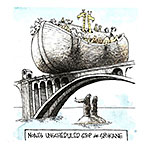
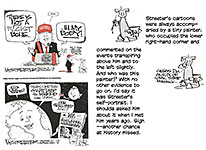
 Brown," in which the bird provides the
impromptu musical accompaniment for Peppermint Party's competitive
figure-skating routine.
Brown," in which the bird provides the
impromptu musical accompaniment for Peppermint Party's competitive
figure-skating routine.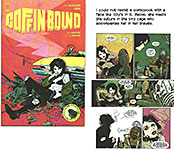
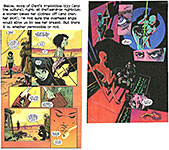
1.jpg)
2.jpg)
3.jpg)
4.jpg)
5.jpg)
1.jpg)
2.jpg)
3.jpg)
4.jpg)
5.jpg)
6.jpg)
7.jpg)
8.jpg)
9.jpg)
10.jpg)
11.jpg)
12.jpg)
13.jpg)
14.jpg)
15.jpg)

